Career paths are being reshaped—some say permanently—partly because of the massive movement toward temporary or contingent employment and the “gig economy.”
A contingent workforce is a provisional group of workers who work for an organization on a non-permanent basis. These contingent workers — or “giggers” — are also known as freelancers, independent professionals, temporary contract workers, independent contractors or consultants. We do not include workers who form part of an outsourcing arrangement with a third party as part of the contingent workforce.
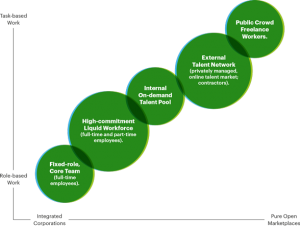
Globally, demand for contingent workers is booming. Accenture presented their technology visions for the insurance and banking sectors and found 30% of insurers are already using talent marketplaces on a broad scale and 48% in some business areas. 62% of Insurance executives surveyed planned to increase their contingent workforce over the next year. In banking, it was an even greater volume with findings that 16% of the workforce are already independent freelancers and 29% of bankers expecting freelance contractors to increase more than 51% over the next year.
There has been a particular increase in white collar contingent workers. In Europe research by the European Forum of Independent Professionals showed the numbers of freelance workers in Europe increased by 45% to nearly 9 million freelancers from 2004 to 2013. The report also found that in the financial services sector full-time employment fell by 0.4%, but the number of independent professionals engaged by financial services organisations increased by 12%.
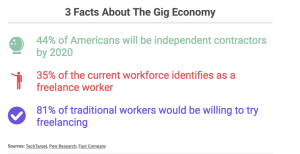
In a recent survey we conducted of employers in the US, 50% of organizations indicated that they had increased their use of gig workers in the last five years. And it seems to be more than a passing trend, as two in five organizations expect to increase their use of the contingent workforce by 2020. In fact, one in three employers of 100,000 employees or more expect to use 30% or more contingent workers in the same timeframe. “We are seeing a convergence of cost reduction initiatives and the need for employers to have more agility, with workers looking for more flexibility. Together, these objectives are driving a shift toward a contingent workforce,” says Tony Steadman, Americas Total Talent Supply Chain Advisory Leader
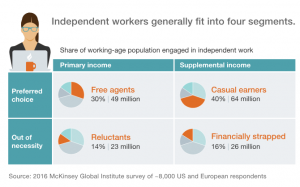 To better understand the independent workforce and what motivates the people who participate in it, the McKinsey Global Institute surveyed some 8,000 respondents across Europe and the United States. We asked about their income in the past 12 months—encompassing primary work, as well as any other income-generating activities—and about their professional satisfaction and aspirations for work in the future.
To better understand the independent workforce and what motivates the people who participate in it, the McKinsey Global Institute surveyed some 8,000 respondents across Europe and the United States. We asked about their income in the past 12 months—encompassing primary work, as well as any other income-generating activities—and about their professional satisfaction and aspirations for work in the future.
The resulting report, Independent work: Choice, necessity, and the gig economy, finds that up to 162 million people in Europe and the United States—or 20 to 30 percent of the working-age population—engage in some form of independent work. While demographically diverse, independent workers largely fit into four segments (exhibit): free agents, who actively choose independent work and derive their primary income from it; casual earners, who use independent work for supplemental income and do so by choice; reluctants, who make their primary living from independent work but would prefer traditional jobs; and the financially strapped, who do supplemental independent work out of necessity.
One of the main arguments against part-time work is that forced part-time workers share far less than full-timers in economic prosperity. Companies invest less in their training; they get less work experience, and fewer promotions.
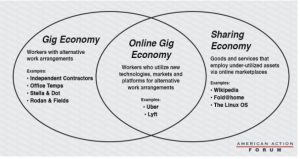
Steven Greenhouse, writing in the New York Times, argues “Over the past two decades many major retailers went from a quotient of 70 to 80 percent full-time to at least 70 percent part-time…[and]the retail and wholesale sector has cut a million full-time jobs since 2006, while adding more than 500,000 part-time jobs.” Susan J. Lambert, a professor of organizational theory at the University of Chicago says that the use of part-timers has escalated because of the declining power of labor unions.
Findings from Adobe revealed that as many as one-third of the 1,000 U.S. office workers they polled had a second job and more than half (56%) predicted we would all have multiple jobs in the future. The annual report from Upwork and the Freelancers Union found that more people than ever are choosing to freelance, up to 55 million this year, or 35% of the total U.S. workforce. As many as 81% of traditional workers they surveyed said they would “be willing to do additional work outside of [their] primary job if it was available and enabled [them] to make more money.”
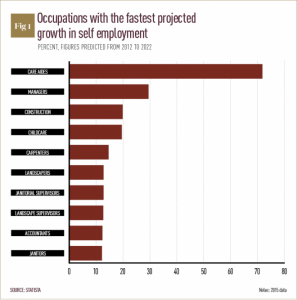
And it doesn’t stop at part-time work. We’re also witnessing the growth of young people working for nothing as interns. Some would argue that by 2050, half of the workforce will be unpaid interns.
Technology firm Mavenlink’s report, “The New Independent Workforce,” shows a significant increase in the number of self-employed, independent service firms, solopreneurs and temporary workers in the U.S. The firm predicts the contingent workforce to grow by 40% by the year 2020 or 65 million people and will not work in what we know as traditional jobs where they work consistently for one employer who provides benefits and insurance.
According to a recent survey from Millennial Branding and Payscale, millennials are now most likely to be employed in service industry jobs. This reflects a report by the Economic Policy Institute, which predicts 30% of American workers are expected to hold low-wage jobs—defined as earnings at or below the poverty line to support a family—by the year 2020. Given that roughly 50% of recent college graduates are unemployed or underemployed and those who do work are much more likely to hold these types of jobs, the prosperity prospects for the young are bleak.
The Downside of Contingent Work
A 2013 Gallup poll reported one of every five workers is now part-time. And according to the U.S. Department of Labor, 30% of all part-timers fall into the involuntary category. The New York Times reported that another rising trend is employers changing part-time workers’ schedules from week to week, with only 10% of part-timers having a set weekly schedule.
The prospect of a generation of workers who are facing job insecurity and uncertain career growth has broader social consequences that go far beyond the critics’ view of millennials being an entitled generation. According the Pew Charitable Trusts foundation, “Americans raised at the top and bottom of the income ladder are likely to remain there themselves. Forty-three percent of those who start in the bottom are stuck there as adults, and 70 percent remain below the middle quintile. Only 4 percent of adults raised in the bottom make it all the way to the top, showing that the “rags-to-riches “story is more often found in Hollywood than in reality.”

Over the past two decades, job security has become unraveled, accompanied by a deterioration in benefits, livable wages and clearly defined career pathways. We are witnessing a fundamental shift in the nature of employment, or social contract.Cathy Davidson, professor at the Graduate Center of the City University of New York and author of The New Education, calls this the “Uberization of professions,” in which income is cobbled together from freelance work, or a variety of jobs, instead of a singular career path.With the rise of the so-called gig economy, workers’ advocates and some state departments of labor are raising concerns about full or part-time employees who are forced to sign agreements that free their employers from keeping them safe.
The labour market is complicated but our social-insurance systems are simple. Think about it: if you are employed full-time, you get paid regularly, and if you are unemployed, you are eligible for employment insurance (EI).
What happens, though, if you work two part-time jobs or a short-term contract or are self-employed? The need to think beyond “binary” employment status was highlighted last week by the International Monetary Fund (IMF) in their World Economic Outlook. In their words, “the rise of part-time employment and temporary contracts challenges the current structure of social-insurance systems.” Translation: the gig economy is happening, so the policies that made sense during the Great Depression may not be a fit for the realities of the 21st century.
Sanjay Sathe, CEO of career coaching platform RiseSmart, sees gigging evolving out of traditional roles. “Where freelancing was most often thought of for creative work (editors, graphic designers, web designers) and contracting was thought of for IT-related positions (programmers, project managers), the gig economy has begun to encompass all types of roles,” he explains, including senior-level executive positions in career paths such as finance, accounting, and IT.
Sathe believes that making space for gig work across an organization will make it more agile and responsive to the market: “While 67% of companies do presently limit the number of these types of positions, according to 2016 Workforce for the Future Survey, having gig positions means they are able to onboard new talent and off-board unneeded skills without the burden of employment taxes and paperwork.”
Companies in the gig economy, including ride-hailing services such as Uber and Lyft, are confronting the consequences of providing flexible schedules with minimum employer responsibilities, says Jessica Martinez, co-executive director of the National Council for Occupational Safety and Health.
“Workers who work in the gig economy are making money but missing out on other standard benefits of having jobs: health care primarily but also paid sick leave and worker’s compensation,” she tells Here & Now’s Robin Young. “It’s essentially the Tinder economy. When a temp worker is done with his or her shift, the boss swipes left and claims to have no further obligation.”
The growth of the temporary and contract labor force and disappearance of full time, career path employment will have permanent damaging effects on the economic welfare of the middle class, particularly today’s young people with aspirations to live the prosperous life of middle class success.
As a result of employers classifying these workers as independent contractors, Martinez says many workers unknowingly sign agreements that strip away their rights. “Some, if not most, agreements do not allow workers to pursue civil action if their rights are violated and must go into arbitration,” she says. “In some states, there’s no really legal legislation that protects temp workers.”
Protecting Gig Workers Rights
As technology provides more opportunities for growth in the gig economy, Martinez says several states are moving forward with legislation to protect the rights of independent workers. State lawmakers in New York and Washington are pushing for legislation that imposes a fee on gig economy transactions and creates an independent pool of money to provide portable benefits for workers, she says. Lawmakers in Congress have alsointroduced a bill that would fund pilot programs for portable benefits.
An Increasing Number of Workers Prefer Contingent and Gig Work
Faith Popcorn, CEO and founder of Faith Popcorn’s BrainReserve, tells Fast Company not to overlook the impact millennials will have on the gig economy. The largest cohort in the workforce “inherited a bad economy, have little prospect of home ownership, and come bearing deep college debt,” Popcorn says, so “the idea of one career seems increasingly untenable.” She believes that automation and AI will only accelerate the rise of gigging. “Ironically, automations like self-driving cars will eliminate some jobs (i.e., driving for Uber), and give way to new forms of gigging yet undiscovered,” she says.
Workers are expressing an increasing demand for autonomous and flexible work. This is particularly evident amongst youth, signalling a generational shift towards greater freedom and entrepreneurship. Although this younger generation is the driving force behind flexible work demands, older workers also want to set their own schedules, choose their tasks and work in an environment that suits them. A recent study by recruitment firm Hays revealed that 55% of those surveyed would take a 20 per cent salary cut in order to work from home. A further 22% would sacrifice 10 per cent of annual income in return for flexible working arrangements.
Airtasker’s 2015 survey of the future of work revealed that 85% of Australians believe that the traditional 9 to 5 office hours are inflexible for both present and future workers. With the advance of digital freelance marketplaces, high speed internet and high-powered mobile computing tools, the complete autonomy that accompanies freelance work is more attainable than ever. As more people realise the benefits of working independently, the freelance economy will continue to influence the workforce and in turn, the economy.
Summary:
So the growth of contingent work brings together several forces: first, it’s clear that traditional ways of organizing work around permanent jobs located in single dedicated spaces is being impacted by at-home work arrangements and contingent work; second, technology and Artificial Intelligence will restructure how work is done with an increasing number of contingent workers. And finally, the traditional social contract with fixed rules and arrangements between employers and employees are necessitating revisions by the prevalence of contingent work.
Copyright: Neither this article or a portion thereof may be reproduced in any print or media format without the express permission of the author.
Read my latest book:Eye of the Storm: How Mindful Leaders Can Transform Chaotic Workplaces, available in paperback and Kindle on Amazon and Barnes & Noble in the U.S., Canada, Europe and Australia and Asia.



